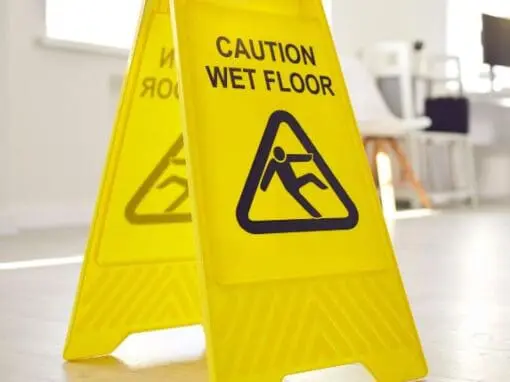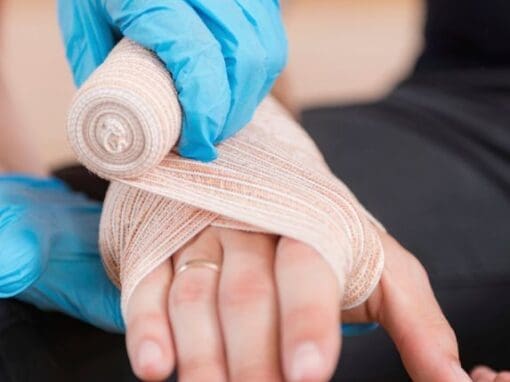What you will learn
This online Workplace First Aid Training will help you recognise emergency medical situations in the workplace and enable you to confidently take appropriate actions when an incident occurs.
By the end of the course you will be able to:
- Understand the importance of aiding those injured or ill in the workplace through first aid.
- Learn first aid principles, your legal responsibilities as an organisation, consent processes and the key responsibilities of a first aider.
- Develop skills to stay composed, assess emergencies accurately, recognise hazards, prioritise treatments and implement comprehensive post-incident cleaning and infection control.
- Get an insight into the respiratory system, consciousness levels, unconsciousness causes, airway management, breathing assessment, positioning for recovery, CPR methods in adults, children and babies, AED operation and the chain of survival.
- Understand epilepsy, identify different seizure types and provide appropriate first aid.
- Understand what asthma is, distinguish between its mild and severe forms and apply suitable first aid.
- Learn to manage various wounds, control bleeding and handle shock situations.
- Recognise diabetic emergencies and offer correct first aid.
- Differentiate burn types and administer proper first aid, understanding when to seek emergency medical help.
- Identify choking incidents in infants, children and adults and provide first aid for minor and severe cases, including addressing hypoxia risks.
- Recognise anaphylactic shock signs and understand how to deliver emergency first aid.
- Recognise signs and symptoms of head injuries and understand the appropriate first aid treatments.
- Respond to a suspected stroke casualty by understanding the various causes, signs and symptoms.
- Recognise and take effective first aid action if you suspect a spinal trauma.
- Understand the circulatory system, the consequences of significant blood loss, heart attacks and how to respond to a cardiac arrest.
- Administer first aid for hyperventilation, including knowing the latest treatment methods.
- Provide immediate treatment for poisoning and understand how poisonous substances enter the body.
- Treat minor injuries like bruises, cuts, abrasions, splinters, nosebleeds, eye injuries and sprains effectively.
- Identify the common signs and symptoms of different types of fractures and learn effective first aid responses for their treatment.
Modules
Your Title Goes Here
1. Introduction
2. A First Aider's Role and Responsibility
3. Evaluating a Medical Incident and Responding
4. Handling an Unresponsive Casualty
In this module, you will be taught the fundamentals of attending to an unresponsive person. You will get an overview of how the respiratory system works and methods to check for consciousness. You will then learn how to ascertain whether someone is breathing normally and explore possible causes of unconsciousness. The module then covers proper cardiopulmonary resuscitation (CPR) techniques for babies, children and adults, emphasising the use of protective barriers to reduce infection risks and situations where only chest compressions are necessary. Finally, the module will guide you through using an Automated External Defibrillator (AED) and demonstrate how to position someone in the recovery position.
5. Managing Epilepsy
6. First Aid for Asthma Attacks
7. Understanding Diabetic Emergencies
8. Helping an Individual Choking
In this module, you will learn how to recognise an adult, baby or child who is choking and effectively treat them. You will also be able to identify signs of hypoxia and provide the necessary first aid treatment.
9. The Circulatory System and Heart Function and Treating Major Blood Loss, Heart Attacks and Cardiac Arrests
10. Responding to a Stroke
In this module, you will learn how to respond to a casualty displaying signs of a suspected stroke. You will gain an understanding of the various causes of strokes and be able to identify a stroke’s signs and symptoms, as a prompt response can greatly influence a positive outcome.
11. Treating External Bleeding and Shock in Casualties
12. Managing Head Injuries
13. Spinal Injury First Aid
In this module, you will learn how to recognise and respond to suspected spinal injuries and trauma. You will learn to identify the signs and symptoms of spinal injuries, master the correct procedures for stabilising and supporting the head and neck and understand when and how to apply the jaw-thrust technique for optimal airway management.
14. Fracture Management
In this module, you will learn to identify the common signs and symptoms of different types of fractures, which may include pain, swelling, deformity and loss of function. In addition, you will understand the benefits of immobilising a fractured limb and learn the correct first aid techniques to ensure safe and effective fracture management.
15. How to Handle an Anaphylactic Shock Response
16. Identifying and Dealing with Burns
17. Dealing with Poisoning
18. Treating Minor Injuries
19. Hyperventilating
Who is this course for?
Certification
This online Workplace First Aid Training is accredited by The CPD Group.
Upon successful completion of this course, you’ll be sent a personalised digital certificate as a PDF, enabling you to download and print it.
You can access a copy, reprint or download this certificate on our LMS (Learning Management System). This is your proof that you have been trained in health and safety best practices and achieved compliance. The certificates include a verification number so anybody can authenticate the certificate’s legitimacy.
Our certifications include a renewal date but there is no legal requirement to renew your training and certificate within a specific timeframe. However, we do recommend that you arrange refresher training after 2 years so you remain confident in administering your first aid skills. You should update your health and safety knowledge and skills regularly.


Genuine reviews
Frequently Asked Questions
Your Title Goes Here
Why is first aid training important?
This training is vital for saving lives in emergencies before the emergency services arrive. It equips individuals to confidently address severe situations, like bleeding or shock and minor issues like small burns or cuts. This not only aids in immediate care but also allows emergency services to focus on more critical cases. Furthermore, first aid knowledge is invaluable in everyday life, as emergencies can happen anytime, anywhere.
What first aid training do I need?
- Work Environment and Industry: The type of workplace, such as a construction site, chemical plant or office, dictates the necessary first aid training due to differing hazards.
- Number of Employees: Larger workplaces or those with employees spread out over various areas may require more first aiders.
- Specific Risks: Workplaces with unique hazards like hazardous chemicals, heavy machinery or remote locations may need specialised first aid training.
- Legal Compliance: Understanding and adhering to legal obligations is crucial.
Generally, there are different types of first aid training:
- Emergency First Aid at Work training: This training covers first aid procedures for common injuries and illnesses.
- First Aid at Work training: This comprehensive training is designed for workplaces with higher risks and covers a broader range of scenarios than Emergency First Aid at Work training.
- Pediatric First Aid training: If you work with children or infants, this training is crucial. It focuses on first aid procedures specifically for children.
- Specialised First Aid training: This might include deep diving first aid etc.
- CPR and AED training: This training focuses on cardiopulmonary resuscitation and using an Automated External Defibrillator (AED).
- Workplace First Aid Training: This training is for anybody who is looking to learn or refresh their first aid skills. Anybody can take this type of training if they want an overview/introduction of first aid methods.
What is included in first aid training?
Introduction to First Aid:
- Role of a First Aider: Understanding responsibilities in emergencies.
- First Aid Kit: Learning about kit contents and their uses.
- Incident Reporting: Basics of workplace accident documentation.
Basic First Aid Scenarios:
- Minor Injuries: Treating cuts, scrapes and bruises.
- Serious Conditions: Managing unconsciousness, seizures and other major emergencies.
Key First Aid Topics:
- Allergic Reactions: Managing severe allergies and anaphylaxis.
- Respiratory Emergencies: Treating asthma and choking.
- Circulatory Emergencies: Performing CPR, using defibrillators and responding to heart attacks and strokes.
- Other Emergencies: Handling bleeding, burns and shock.
Essential First Aid Skills:
- Emergency Management: Assessing situations and responding appropriately.
- Calling Emergency Services: When and how to seek professional help.
- Immediate Care: Providing support until medical professionals arrive.
What is the difference between Emergency First Aid at Work (EFAW), First Aid at Work (FAW) training and Workplace First Aid Training?
Workplace First Aid Training
This is a general workplace first aid course and can encompass both FAW and EFAW first aid content.
EFAW training:
- Suitable for employees in ‘low risk’ settings like offices, where accidents are uncommon.
- Topics include essential first aid training, covering all the common scenarios.
- Trains individuals to handle emergency medical situations confidently.
- Requalification is required every three years covering the same content.
FAW training:
- Encompasses EFAW content and additional training for specific injuries and illnesses.
- Allows for broader first aid application, not just emergencies, this could include recognising major illnesses such as heart attacks and epilepsy and administering first aid for specific injuries like head, spine and broken bones as well as eye injuries, poisoning and more.
- Requalification is required every three years.
- This training often takes more than a day to complete.
What is the minimum first aid provision at work?
1. A well-stocked first-aid kit. (Check Q4 in HSE’s First Aid at Work – Your Questions Answered for contents).
2. Designated person to coordinate with emergency services, maintain supplies and provide first aid information. This individual need not be trained in first aid nor expected to administer it.
3. Clear information for staff regarding available first aid resources.
How many appointed first aid staff or first aiders do I need?
For guidance on how many first aiders might be needed, you can refer to the recommendations provided by the Health and Safety Executive (HSE).
How do you decide when to appoint a first aider or just a person to take responsibility for your work place first aid provision?
- The nature of the work.
- The size of the workforce.
- History of past accidents.
- Whether you have remote workers.
- Distance from medical help.
In low-risk settings like small offices, one person might oversee first aid basics. In a high-risk workplace with hazardous materials, like factories or construction sites, they will need trained first aiders. Workplaces with chemical risks may require specialised first aid training. An employer will also need to ensure there is a trained first aider on hand at all times.
What is the difference between the role of a first aider and a person that is appointed to take responsibility for an organisation's first aid provision?
A first aider is required to undergo formal training, such as First Aid at Work or Emergency First Aid at Work, to provide medical assistance in case of illness or injury. In contrast, an appointed person, responsible for managing first aid provisions, doesn’t need a formal first aid qualification. They may possess basic first aid knowledge and are typically tasked with maintaining first aid equipment, calling emergency services and supporting a first aider during medical incidents.




